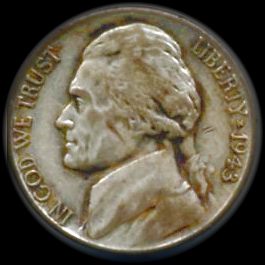Silver "War" nickels were manufactured from 56% copper, 35% silver and 9% manganese. This allowed the saved nickel metal to be shifted to industrial production of miltary supplies during World War II. In 1943, approximately 271 million coins were produced at the Philadelphia Mint, 15 million coins were produced at the Denver Mint and about 104 million coins were made at the San Francisco Mint.
Wartime events of 1943 include: German forces in Stalingrad surrender to Soviet forces (February 2), General Erwin Rommel defeats American forces at Kasserine Pass (February 14), German Afrika Korps surrender to Allies in North Africa (May 13), Soviets defeat Germans in Battle of Kursk (August 23), Allies invade Italy (September 3).
The silver content of these coins means they have greater inherent value than traditionally produced nickels, but they can still be easily added to your coin collection, either by finding them in pocket change (a rare but not impossible occurrence), by trading with other collectors or by obtaining low price specimens from dealers.
|

Bust of Thomas Jefferson on obverse
view of the 1943 Silver Nickel.
|